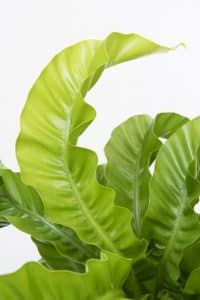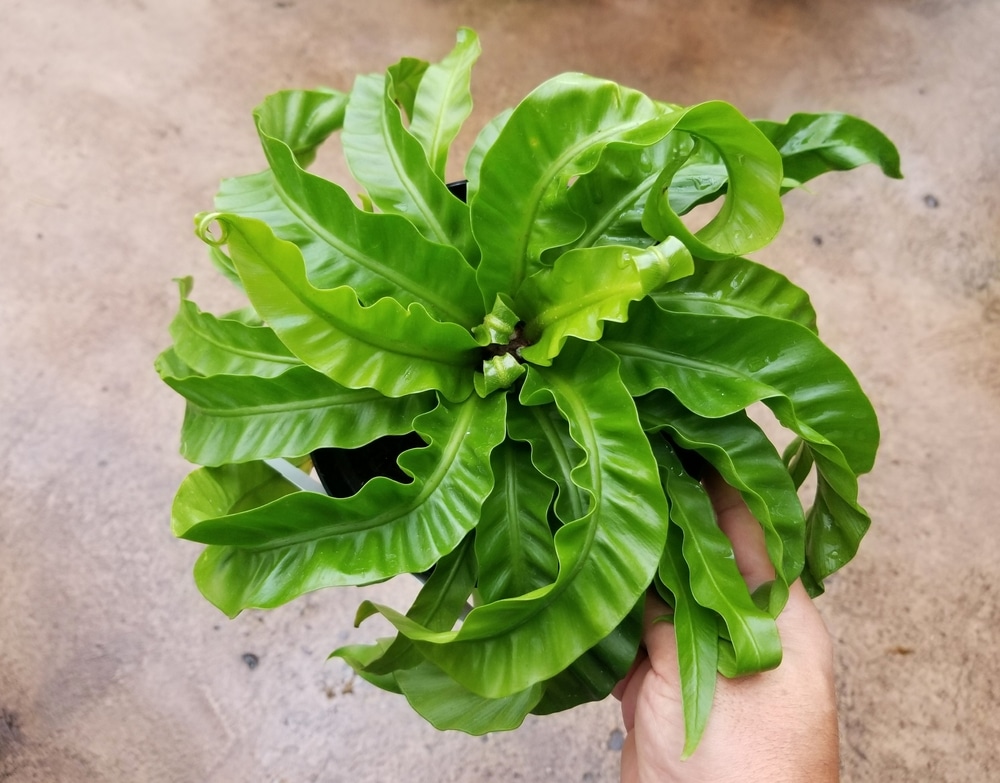If you need a unique-looking plant to spice up your interiors, you might be interested in learning more about the Asplenium hurricane. Also known as Hurricane fern or Twisted Bird nest fern, this plant displays eye-catching and glossy foliage that can add a jungly touch to your indoor spaces.
Also, you can use it as an air purifier in your kitchen or bathrooms. So, does this sound like a plant you would consider for your house? Then, keep reading this essential guide we put together to learn everything you must know about it!

| Botanical Name | Asplenium hurricane |
| Common Name | Twisted Bird’s Nest Fern, Hurricane fern, spleenworts |
| Plant Type | Perennial |
| Flower Color | No flower: ferns reproduce by producing spores |
| Size When Mature | Up to 5 feet tall and 3 feet wide |
| Bloom Time | Not applicable |
| Sun Requirements | Partial Sun or Indirect Light |
| USDA Hardiness Zones | 5-9 |
| Soil PH Range | Between 5.0 and 6.0 |
| Soil Type | Well-draining, moist, slightly acidic |
| Water Needs | Medium |
| Native Area | Eastern Asia |
What you Need to Know About Asplenium Hurricane
Despite its delicate looks, the Asplenium hurricane is relatively easy for care houseplants. It works well in containers (and hanging baskets) and might get large under ideal conditions. So, keep that in mind before getting one for your home. The foliage grows in a twisted pattern, which can add a unique touch to your interiors.
If you have curious pets or kids, you have nothing to worry about the Asplenium hurricane. Indeed, this plant is non-toxic, meaning it will not cause problems to your animals or little humans.
As with any ferns, the Asplenium hurricane does not produce flowers. But, with the proper care, it will give you lush and attractive foliage.
How to Care for Asplenium Hurricane
As you may already know, low-maintenance plants still need some attention from your side. Keep reading to learn all you need to know about growing a thriving twisted bird’s nest fern in your house. Keep in mind that these plants usually grow slowly: but be patient as it will be worth it!
Light
Place your plant in a location that receives indirect light to avoid scorching your Asplenium leaves. Also, consider adding shears to your windows to reduce sunlight damage to the minimum. And if you can, place them next to a north-facing window: it will reduce the risk of burning to almost zero. Remember to rotate your plant to ensure an even growth pattern!
Water and Soil Needs
While Asplenium hurricanes need moist growing conditions, you should always feel the soil with your fingers before watering them. Failing to do so might result in overwatering or root rotting, which can severely damage your plant.
Also, ensure you plant your fern in a suitable pot with adequate drainage holes. Since these plants thrive in humid conditions, we recommend you mist it for at least a couple of days per week.
The good news is that this fern variety isn’t too fussy about soil conditions. You can use regular potting mixes, but ensure they drain excellently. You can add some perlite to decrease compaction. Plus, consider placing a layer of mulch to improve drainage and increase water retention.
Also, don’t forget to transplant your plant to a larger container when you notice it outgrowing your pot. Also, ensure the pH levels are lower than 6.0: Asplenium hurricane thrives in slightly acidic conditions!
Temperature Requirements
Asplenium hurricane is a houseplant that doesn’t perform well at temperatures below 50°F. For this reason, you should keep it in rooms between 60 and 70°F. Avoid placing it next to a heater or air conditioning device. This fern variety will struggle without humidity. For this reason, many gardeners decide to put it in their bathrooms!
Fertilizer
If you don’t like spending too much time taking care of your plants, you’ll be relieved knowing that the Asplenium hurricane doesn’t require extra feeding. Indeed, with a suitable substrate, you may not have to purchase any fertilizer. Still, if your plant looks unhappy, consider applying a weak solution during the growth season. Alternatively, enrich the soil with some compost.
Common Diseases
This plant has a relatively high resistance to most diseases and rarely suffers from pest attacks. Still, it may be a good idea to check your plant regularly. And if you notice something off with it, take proper measures. Remember: always choose organic solutions before trying synthetic pesticides!

